Python趣味挑戰(zhàn)之教你用pygame畫進(jìn)度條
import pygamepygame.init()screen = pygame.display.set_mode((500,300))pygame.display.set_caption('好看的進(jìn)度條顯示V1.0')clock = pygame.time.Clock()while True: for event in pygame.event.get():if event.type == pygame.QUIT or event.type == pygame.K_F1: pygame.quit() sys.exit() screen.fill((255,255,255)) clock.tick(30) pygame.display.flip()
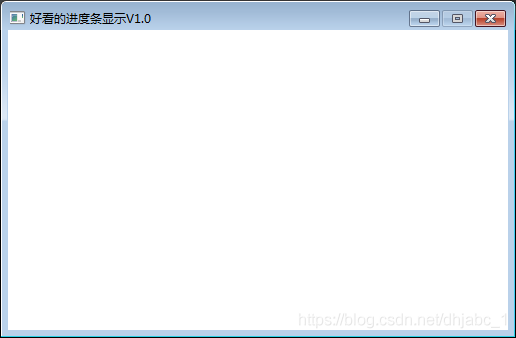
(一)核心代碼
pygame.draw.rect(screen,(192,192,192),(5,100,490,20)) pygame.draw.rect(screen,(0,0,255),(5,100,step,20))
(二)設(shè)置步長,并循環(huán)遞增
step += 1
(三)完整代碼
import pygame,syspygame.init()screen = pygame.display.set_mode((500,300))pygame.display.set_caption('好看的進(jìn)度條顯示V1.0')clock = pygame.time.Clock()step = 0while True: for event in pygame.event.get():if event.type == pygame.QUIT or event.type == pygame.K_F1: pygame.quit() sys.exit() screen.fill((255,255,255)) # screen.fill((0,0,0)) pygame.draw.rect(screen,(192,192,192),(5,100,490,20)) pygame.draw.rect(screen,(0,0,255),(5,100,step % 490,20)) step += 1 clock.tick(60) pygame.display.flip()
(四)運行效果
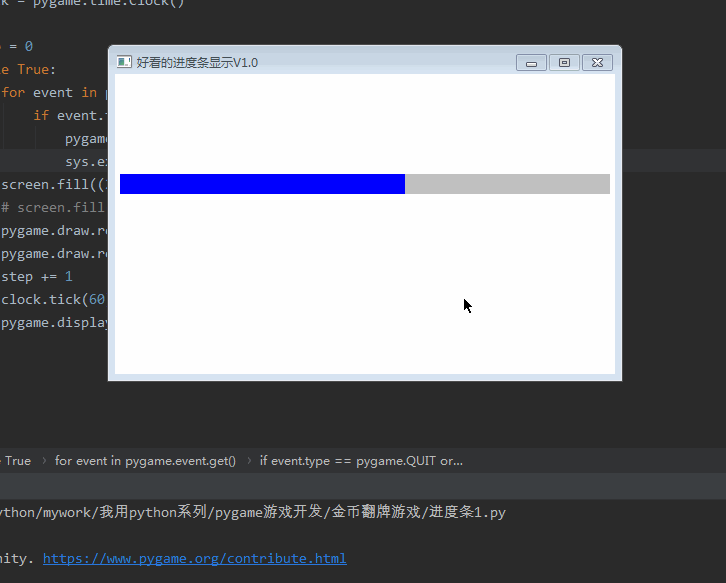
(一)核心代碼
pygame.draw.rect(screen,(192,192,192),(5,100,490,20)) pygame.draw.rect(screen,(0,0,255),(5,100,step % 490,20)) font1 = pygame.font.Font(r’C:WindowsFontssimsun.ttc’, 16) text1 = font1.render(’%s %%’ % str(int((step % 490)/490*100)), True, (255,0,0)) screen.blit(text1, (245, 100))
(二)完整代碼
import pygame,syspygame.init()screen = pygame.display.set_mode((500,300))pygame.display.set_caption('好看的進(jìn)度條顯示V1.0')clock = pygame.time.Clock()step = 0while True: for event in pygame.event.get():if event.type == pygame.QUIT or event.type == pygame.K_F1: pygame.quit() sys.exit() screen.fill((255,255,255)) # screen.fill((0,0,0)) pygame.draw.rect(screen,(192,192,192),(5,100,490,20)) pygame.draw.rect(screen,(0,0,255),(5,100,step % 490,20)) font1 = pygame.font.Font(r’C:WindowsFontssimsun.ttc’, 16) text1 = font1.render(’%s %%’ % str(int((step % 490)/490*100)), True, (255,0,0)) screen.blit(text1, (245, 100)) step += 1 clock.tick(60) pygame.display.flip()
(三)運行結(jié)果
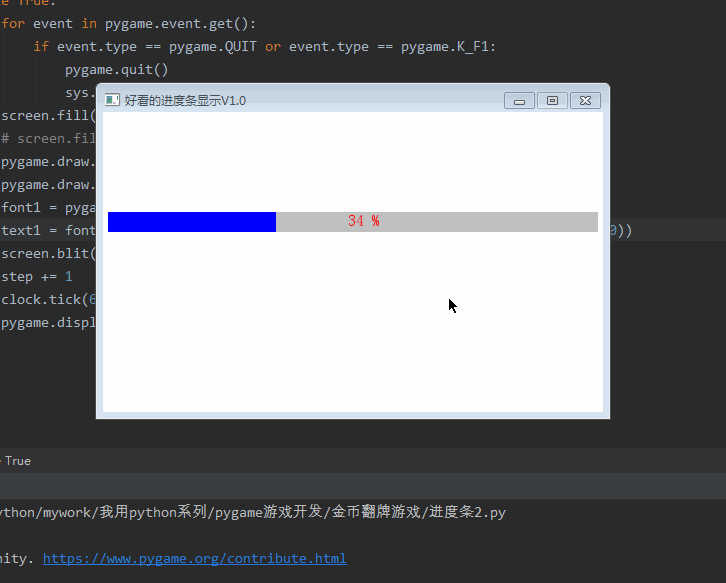
(一)核心代碼
pygame.draw.rect(screen,(192,192,192),(5,100,length+10,20)) pygame.draw.rect(screen,(0,0,255),(5,100,step % length,20)) pygame.draw.circle(screen,(0,0,255),(step % length,110),10) font1 = pygame.font.Font(r’C:WindowsFontssimsun.ttc’, 16) text1 = font1.render(’%s %%’ % str(int((step % length)/length*100)), True, (255,0,0)) screen.blit(text1, (245, 100))
(二)完整代碼
import pygame,syspygame.init()screen = pygame.display.set_mode((500,300))pygame.display.set_caption('好看的進(jìn)度條顯示V1.0')clock = pygame.time.Clock()step = 0length = 480while True: for event in pygame.event.get():if event.type == pygame.QUIT or event.type == pygame.K_F1: pygame.quit() sys.exit() screen.fill((255,255,255)) # screen.fill((0,0,0)) pygame.draw.rect(screen,(192,192,192),(5,100,length+10,20)) pygame.draw.rect(screen,(0,0,255),(5,100,step % length,20)) pygame.draw.circle(screen,(0,0,255),(step % length,110),10) font1 = pygame.font.Font(r’C:WindowsFontssimsun.ttc’, 16) text1 = font1.render(’%s %%’ % str(int((step % length)/length*100)), True, (255,0,0)) screen.blit(text1, (245, 100)) step += 1 clock.tick(60) pygame.display.flip()
(三)運行效果
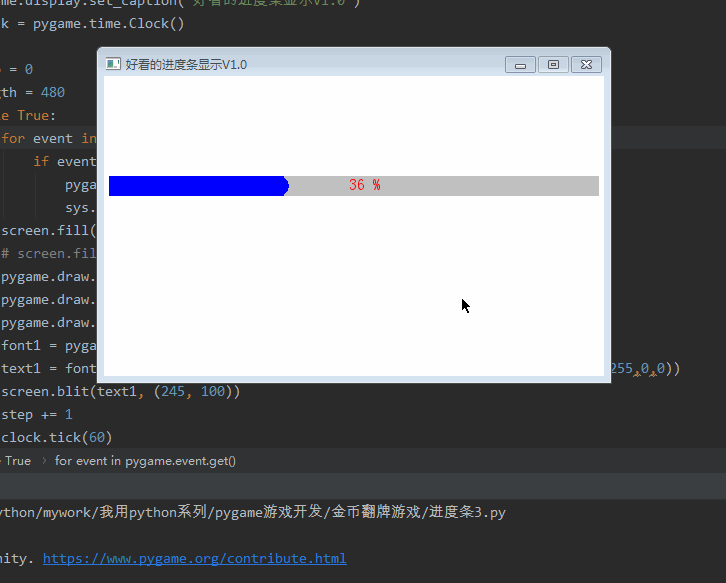
(一)加載圖片資源
picture = pygame.transform.scale(pygame.image.load(’score/5.png’), (20, 20))
(二)畫進(jìn)度條
pygame.draw.rect(screen,(192,192,192),(5,100,length+10,20)) pygame.draw.rect(screen,(251,174,63),(5,100,step % length,20))
(三)畫圖片資源
screen.blit(picture,(step%length,100))
(四)畫文字
font1 = pygame.font.Font(r’C:WindowsFontssimsun.ttc’, 16) text1 = font1.render(’%s %%’ % str(int((step % length)/length*100)), True, (255,0,0)) screen.blit(text1, (245, 100))
(五)完整代碼
import pygame,syspygame.init()screen = pygame.display.set_mode((500,300))pygame.display.set_caption('好看的進(jìn)度條顯示V1.0')clock = pygame.time.Clock()picture = pygame.transform.scale(pygame.image.load(’score/5.png’), (20, 20))step = 0length = 480while True: for event in pygame.event.get():if event.type == pygame.QUIT or event.type == pygame.K_F1: pygame.quit() sys.exit() screen.fill((255,255,255)) # screen.fill((0,0,0)) pygame.draw.rect(screen,(192,192,192),(5,100,length+10,20)) pygame.draw.rect(screen,(251,174,63),(5,100,step % length,20)) screen.blit(picture,(step%length,100)) font1 = pygame.font.Font(r’C:WindowsFontssimsun.ttc’, 16) text1 = font1.render(’%s %%’ % str(int((step % length)/length*100)), True, (255,0,0)) screen.blit(text1, (245, 100)) step += 1 clock.tick(60) pygame.display.flip()
(六)運行效果
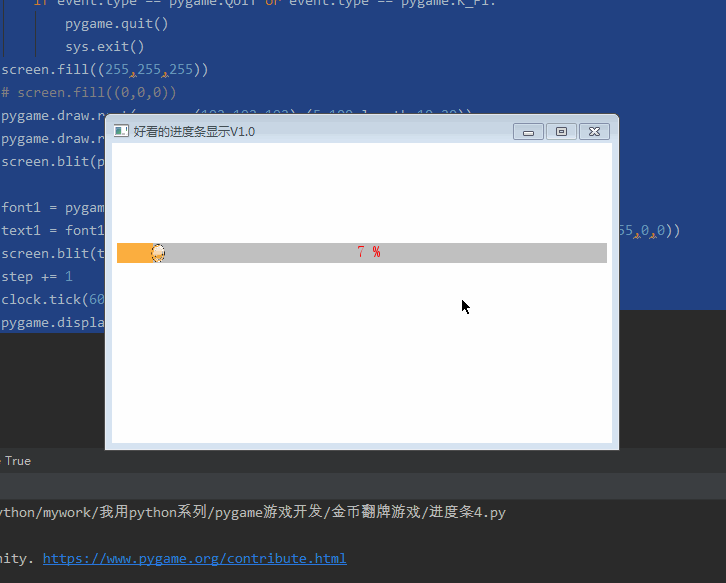
(一)完整代碼
import pygame,syspygame.init()screen = pygame.display.set_mode((500,300))pygame.display.set_caption('好看的進(jìn)度條顯示V1.0')clock = pygame.time.Clock()picture = pygame.transform.scale(pygame.image.load(’score/5.png’), (20, 20))step = 0length = 480while True: for event in pygame.event.get():if event.type == pygame.QUIT or event.type == pygame.K_F1: pygame.quit() sys.exit() screen.fill((255,255,255)) # screen.fill((0,0,0)) # 第一種 pygame.draw.rect(screen,(192,192,192),(5,100,490,20)) pygame.draw.rect(screen,(0,0,255),(5,100,step % 490,20)) # 第二種 pygame.draw.rect(screen,(192,192,192),(5,150,490,20)) pygame.draw.rect(screen,(0,0,255),(5,150,step % 490,20)) font1 = pygame.font.Font(r’C:WindowsFontssimsun.ttc’, 16) text1 = font1.render(’%s %%’ % str(int((step % 490)/490*100)), True, (255,0,0)) screen.blit(text1, (245, 150)) # 第三種 pygame.draw.rect(screen,(192,192,192),(5,200,length+10,20)) pygame.draw.rect(screen,(0,0,255),(5,200,step % length,20)) pygame.draw.circle(screen,(0,0,255),(step % length,210),10) font1 = pygame.font.Font(r’C:WindowsFontssimsun.ttc’, 16) text1 = font1.render(’%s %%’ % str(int((step % length)/length*100)), True, (255,0,0)) screen.blit(text1, (245, 200)) # 第四種 pygame.draw.rect(screen,(192,192,192),(5,250,length+10,20)) pygame.draw.rect(screen,(251,174,63),(5,250,step % length,20)) screen.blit(picture,(step%length,250)) font1 = pygame.font.Font(r’C:WindowsFontssimsun.ttc’, 16) text1 = font1.render(’%s %%’ % str(int((step % length)/length*100)), True, (255,0,0)) screen.blit(text1, (245, 250)) step += 1 clock.tick(60) pygame.display.flip()
(二)運行效果
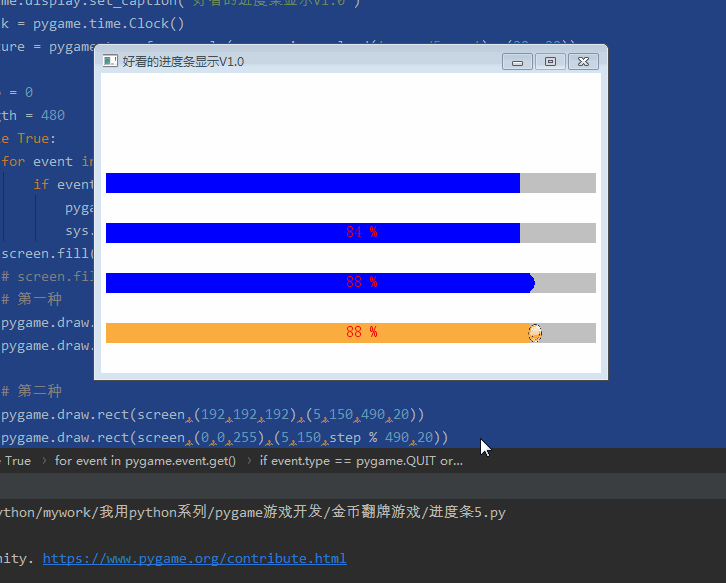
OK,寫完,本博文純屬科普貼,技術(shù)含量不高,入門級別,大家喜歡就好。而且里面代碼相對比較簡單,也沒有考慮優(yōu)化,大家在實操過程中可以優(yōu)化完善,并反饋給我一起進(jìn)步。
到此這篇關(guān)于Python趣味挑戰(zhàn)之教你用pygame畫進(jìn)度條的文章就介紹到這了,更多相關(guān)pygame畫進(jìn)度條內(nèi)容請搜索好吧啦網(wǎng)以前的文章或繼續(xù)瀏覽下面的相關(guān)文章希望大家以后多多支持好吧啦網(wǎng)!
相關(guān)文章:
1. HTTP協(xié)議常用的請求頭和響應(yīng)頭響應(yīng)詳解說明(學(xué)習(xí))2. HTML DOM setInterval和clearInterval方法案例詳解3. HTML5實戰(zhàn)與剖析之觸摸事件(touchstart、touchmove和touchend)4. React優(yōu)雅的封裝SvgIcon組件示例5. HTML5 Canvas繪制圖形從入門到精通6. XML入門的常見問題(三)7. Vue如何使用ElementUI對表單元素進(jìn)行自定義校驗及踩坑8. CSS清除浮動方法匯總9. XML在語音合成中的應(yīng)用10. 不要在HTML中濫用div

 網(wǎng)公網(wǎng)安備
網(wǎng)公網(wǎng)安備